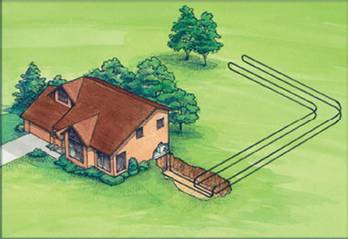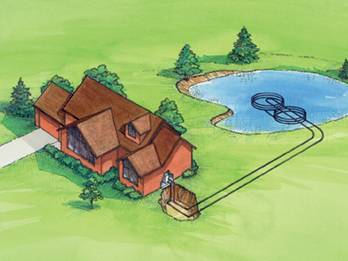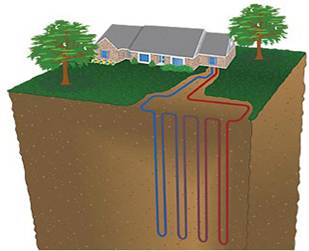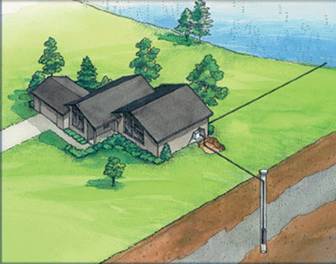How it Works
Horizontal Loop Energy System

These types of loops can be installed very cost-effectively for a home located near a lake or pond. Many homes in Ontario, for example, are within meters of a lake that soaks up the sun's energy all summer. The water temperature at the bottom of an ice-covered lake is about 4 to 5 degrees Celsius even during the coldest blizzard. And in the summer, the lake water can easily absorb the heat you are trying to expel to cool your home. All you need is a year-round minimum depth of water in which the loop can be protected from wave action and ice pile-ups. Unless you own the lake, however, you will probably need permission from the provincial government to install a lake loop. In some jurisdictions, enough lake loops have been installed that permission is simply a matter of filling out forms.
As the name implies, these loops are buried horizontally, usually at the depth of about 5' to 6' in a trench. These trenches 4' wide would be approximately 250' - 300' in length per ton. A typical 2500 square feet home would require 4 trenches which would provide all the renewable energy you would need to heat and cool your home.
Lake or Pond Loop Energy System

These types of loops can be installed very cost-effectively for a home located near a lake or pond. Many homes in Ontario, for example, are within meters of a lake that soaks up the sun's energy all summer. The water temperature at the bottom of an ice-covered lake is about 4 to 5 degrees Celsius even during the coldest blizzard. And in the summer, the lake water can easily absorb the heat you are trying to expel to cool your home. All you need is a year-round minimum depth of water in which the loop can be protected from wave action and ice pile-ups. Unless you own the lake, however, you will probably need permission from the provincial government to install a lake loop. In some jurisdictions, enough lake loops have been installed that permission is simply a matter of filling out forms.
Vertical Loop Energy System 
Land size dictates if a vertical closed loop system is required. Geothermal pipe is inserted into holes drilled into the ground. These boreholes are usually 150' to 175' deep but can be multiple shallower boreholes. The main advantage of a vertical loop is it allows it to be installed in a much smaller area than a horizontal loop. The vertical installation can vary greatly but usually costs more than a horizontal installation.
Open Well Loop Energy System 
If your well will yield a sufficient amount (15 gpm or more) of good quality water there is no need for a horizontal or vertical closed loop. Typically, you will also need a second or return well to dispose of the water by pumping it back into the earth. Some installations can discharge the water to a pond or leaching field. Regulations on the consumption of well water and discharge method for use as energy for a geothermal heat pump may vary with each municipality and province. Although this installation will usually costs less than a closed loop, the maintenance regarding the well, well pump and controls have to be considered when deciding on what type of installation you would like.
